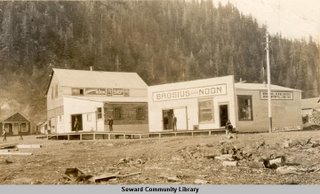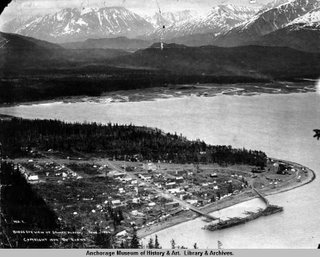

In the latter part of 1901, John E. Ballaine decided to organize and promote a railroad from the Pacific Coast through Central Alaska to the Yukon valley.
His first aim was to establish an ocean terminus at a year-round harbor with good shelter and ample depth of water. The location needed level ground for wharves and bunkers at the railroad terminal facilities, as well as adjacent room for factories and smelters. From every source of available information Tyoonok, Seldovia, Knik, Port Well, Valdez, Illiamna, Cordova Bay, Port Nelle Juan, and Controller Bay were examined.
“I held the view that the ocean terminus was of prime importance for it would serve all future generations and in time become one of the world’s important centers of commercial and industrial activity.” Ballaine suggested in the January 1, 1906 edition of the Seward Daily Gateway.
In 1898, United States Army Captain Glenn had started from Resurrection Bay with a government exploration party to cooperate with similar parties starting from other points on the southern coast of Alaska to find an All American route to the Klondike for a trail, wagon road, or railroad.
“Odd as it may now seem,” Ballaine offered, “Resurrection Bay was the last that came to my notice, for it was then perhaps the least known harbor on the entire southern coast of Alaska.”
In his report, Captain Glenn stated that Resurrection Bay was one of the best harbors in Alaska and that it connected with a route of easy grades and moderate cost for a wagon road or a railroad, either by way of the Matanuska river to the Klondike, or up the Susitna valley to the Tanana and the Yukon.
By March of 1902 the Alaska Central Railway was organized and Resurrection bay selected as its tentative terminal. R.E. Field’s engineering party was charged with making a detailed survey of Resurrection Bay harbor.
“The reports of the engineers more than confirmed all the favorable information I had previously obtained about Resurrection Bay and the practicability of a route from its head to the interior river,” said Ballaine. “My investigations had convinced me that the resources tributary to the route were diversified and abundant, including gold, copper, high grade coal, and the best timber and agricultural lands in Alaska. I therefore, in November 1902, definitely selected Resurrection Bay as the ocean terminus of the Alaska Central Railway.”
The only residents of the area were Mrs. Mary Lowell and her family. They had lived for eighteen years in the cabin that was still their home. Ballaine speculated that the Resurrection Bay area would be able accommodate an ultimate population of not less than 500,000.
“To some it may appear an extravagance to say that people now living will see at Seward one of the half dozen largest cities on the Pacific Coast,” Ballaine suggested. “The same people in 1880 would have pronounced it impossible for Seattle to attain a population exceeding 10,000 or 12,000 by 1905, as a great many at that time did.”
Ballaine was a child when he moved to Washington with his parents in 1879. “Seattle was then a ragged settlement on the fringe of impenetrable forests.” Ballaine explained. “It had no electric lighting plant, no water works, no daily newspaper, as Seward has today. Seattle in 1880 was further from the center of population, several times over, measured in time of travel, than Seward is in 1905.”
1 comment:
Not to be disrespectful, mean, rude, or anything... but...
I sent you credits to rent space on your blog for this past week, and it seems that you no longer have the featured site code on your page, nor is there any mention or link to my website anywhere on your page.
I feel as though I should be refunded.
Post a Comment